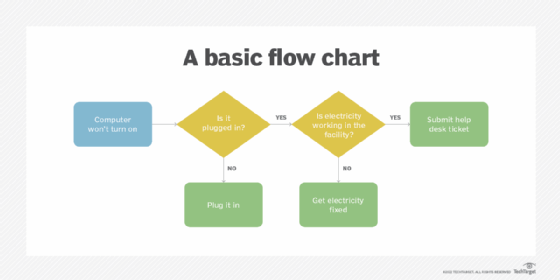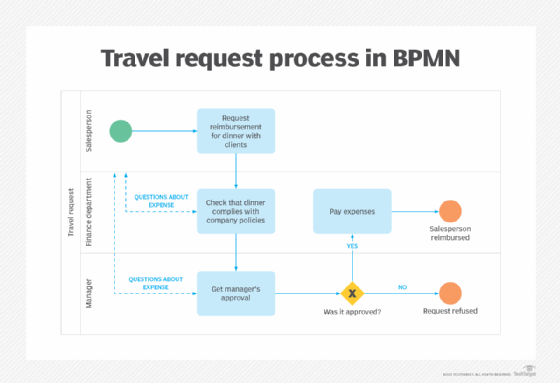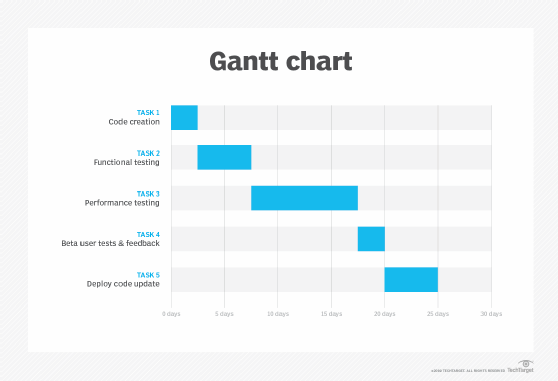What is business process modeling?
Business process modeling, often called process modeling, is the graphical representation or illustration of an organization's business processes.
A business process comprises a logical set of activities or steps executed in a specific order to produce a desired outcome. A process model is a graphical or visual representation of these activities, steps, and goals.
These models include elements like arrows, connectors, activity indicators, and start and end indicators to visually represent how the process flows. Arrows show the order in which the process activities occur; connectors show skips to a later part of the process. Start and end indicators depict the beginning and end of the process, while the activity indicators signify the specific tasks taken to achieve the intended outcome.

Business process modeling is used to map an organization's current (or as is) processes to create a baseline for process improvements and design future (or to be) processes with those improvements incorporated. The aim is to create comprehensive activity diagrams and flowcharts that provide useful, actionable insights into how a process functions and how it could function if improved.
Some of the information process modeling helps to surface includes the following:
- Events and activities in a process and its workflows.
- Activity/event owners.
- Activity/event initiators and enders.
- Decision pathways.
- Consequences of each decision.
- Complete process timeline.
- Each activity's timeline and where it fits into the overall process.
- Process metrics and key performance indicators.
Why use business process modeling
Along with business process discovery, process modeling is widely viewed as a critical component in successful business process management (BPM). One reason is that the model's ability to visually represent a process helps organizations understand its workflows, and more importantly, to implement measures to optimize it.
Process modeling also helps to expose key metrics that can be used to assess process health. Current issues and potential problems might be revealed, enabling the planning and execution of process improvements.
Process modeling can also reveal areas that might be improved by digital transformation initiatives like automation. By clearly showing how the process works and the business logic driving its activities and decisions, a model helps to clarify where implementing automations might help to save time, cut costs, improve productivity, or enhance efficiencies.
The model of a particular process can help in improving other processes. Decision-makers can use one model as a template to identify issues and possible optimization areas in other parts of the business. The template can also standardize the way everyone approaches process management and improvement for existing and new/proposed processes.
Finally, business process modeling is useful to assess process outcomes and ROI. A model helps understand the resources (people, technologies, software, etc.) used in the process and assess whether those investments are beneficial. If they are guzzling money but not generating desired results, management can consider removing those resources and reinvesting the money elsewhere.
Business Process Modeling Notation and Unified Modeling Language
Process modeling often uses Business Process Modeling Notation (BPMN), a standard method of illustrating processes. Also known as Business Process Model and Notation, BPMN uses flowchart-like diagrams that various stakeholders, such as IT and business managers, can understand easily. Its comprehensive nature and ease of comprehension are two reasons BPMN is commonly used in numerous BPM initiatives.

Initially created for software development, Unified Modeling Language (UML) is another method used to visually represent business processes. Its diagrams for behavior, interaction and structure help process modelers visualize, construct, and document parts of a process.
Since they provide standardized visual elements with universally recognized meanings, both BPMN and UML let stakeholders speak the same language when discussing a process. For example, BPMN uses swim lanes that show how people in a process coordinate and share work. UML uses terms such as actor that always have the same meaning, regardless of the process being modeled.
These notations also facilitate easy sharing of the process model. Stakeholders can readily collaborate on planning and implementing process improvements.
How business process models are created
Given the complexity of modern-day organizations and their processes, it's not surprising that process models are rarely created manually. Rather, modelers use data mining algorithms that analyze the information (activities and changes) contained in event logs. Based on these analyses, the algorithm creates a visual representation of the process and its existing workflows.
Today's BPM suites include process modeling tools. These suites are generally easy to use and facilitate process optimization with pre-built business apps, employee management systems, built-in IT asset management capabilities, and bug-tracking. Next-gen BPM software is of the no-code type, meaning even nontechnical users like process managers can easily create process models, build workflows, modify processes, and enable automations.
The form of a process model depends on the process and underlying business need in creating that model. The most common forms are listed below:
- Gantt charts.
- Flowcharts.
- Data flow diagrams.
- UML diagrams.
- BPMN diagrams.
- Functional flow block diagrams.
- Integrated definition for function modeling (IDEF) diagrams.
- Petri nets.
- Role activity diagrams (RADs).
- Role interaction diagrams.

Business process management software is becoming an engine for business transformation as these tools get integrated with powerful AI and hyperautomation features. Explore 12 top business process management tools.